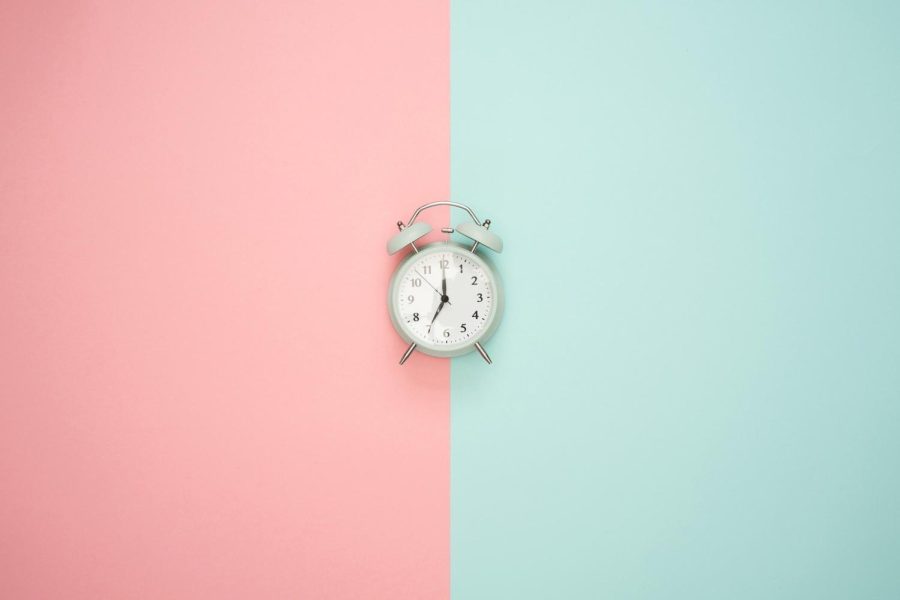It’s Time to Stop the Switch: Evaluating Daylight Saving Time
March 20, 2022
It’s a rainy March 12 evening. You’re finishing up your English homework when you realize that tonight, time is going to “spring forward” and you’re going to lose yet another hour of sleep. You groan as you reluctantly set your alarm clock forward by an hour and go to sleep. The next morning, you wake before the sun, feeling especially groggy as you prepare to head off to school.
Every year, on the second Sunday of March, Americans start Daylight Saving Time (DST) by setting their clocks ahead an hour and “springing forward.” They then reenter standard time on the first Sunday of November by turning their clocks back an hour and “falling back.” Daylight Saving Time was originally enforced during the early 1900s to “maximize” the number of daylight hours that people could spend productively. When we enter Daylight Saving Time, the sun rises and sets later, allowing people to be awake during most of the daylight hours. However, recently, many people have started to dread the switch to DST because it means having to lose an hour of sleep and wake up when it is still dark out. Thus, the Senate has recently (just two days after we “sprang forward”) unanimously voted in favor of making DST permanent. If this bill were to make it past the House of Representatives and President Biden, it would mean staying in DST, as opposed to switching back and forth.
Those who are in favor of staying in DST argue that the lighter evenings will benefit people by making them happier and more alert for longer. The lighter evenings may also correlate with fewer robberies and safer roads (since people will be driving home when it is lighter out). They also claim that the economy would benefit because people may be more comfortable with going out to buy things until nighttime (since the sun sets later).
On the other hand, switching permanently to DST may disrupt our natural circadian rhythm. According to the American Academy of Sleep Medicine, it is more natural for our bodies to wake up with the sun and sleep soon after it sets. When the sun sets later, our body fails to produce necessary hormones, such as melatonin, which trigger our bodies to feel tired; then, waking up becomes more challenging as the mornings are dark. One study suggests that this cycle could lead to as much as 19 fewer minutes of sleep each night. This subsequent sleep deprivation may also lead to other health problems like obesity, heart disease, diabetes, and problems with the regulation of metabolism, insulin, and blood pressure.
This also isn’t our first time trying to get rid of DST. Back in the 1970s, the US tried to switch its time system due to an oil embargo enforced by the Organization of Arab Petroleum Exporting Countries. In an attempt to conserve energy usage, they planned to stay in DST from January 1974 to October 1975. But it soon became apparent that the switch in time was less than favorable. In many parts of the nation, the sun wouldn’t rise until 8:30 am. People hated going to work in the dark, children were forced to wait for buses in the dark, and the number of early-morning accidents increased. Some children even had to wear reflective clothing when waiting for their morning buses. Thus, in October 1974, the law was repealed and Americans went back to switching their clocks twice a year.
Regardless of which time you prefer, we should undoubtedly choose one time to be permanent. . According to the University of Colorado, on the day (and following week) after we “spring forward,” fatal car accidents increase by 6%, causing an extra 28 deaths annually. One 2017 study (done in Denmark) even found that there was an 11% increase in depressive occurrences when it came time to “fall back” to standard time in the fall. Furthermore, the switch throws us off of our daily routines and forces our circadian rhythms to adjust in response.
If we were to change things, it is evident that staying in Standard Time would be better for our health because our time cycle would be most aligned with the sun’s. The lighter mornings are beneficial to those who need to wake up early to go to either school or work. Last year, most people were working through remote or hybrid conditions, and one study even found that people wouldn’t wake up until a mere 10 minutes before they needed to. But now, as more and more people return to their in-person lives, they can no longer wake up 10 minutes before their first appointment or class. Students, in particular, are severely impacted, because unlike some adults, they cannot control their “working” hours. Students need to get to school by a certain time, wake up in the dark when they’re already sleep deprived, and fight their natural circadian rhythms in order to get to school on time. Although having permanent standard time wouldn’t solve these problems, it would help many people align their circadian rhythms with the sun.
For now, it’s time for us to sit back and watch what the House of Representatives and President Biden decide to do—because it’s only a matter of time before the current system changes.








